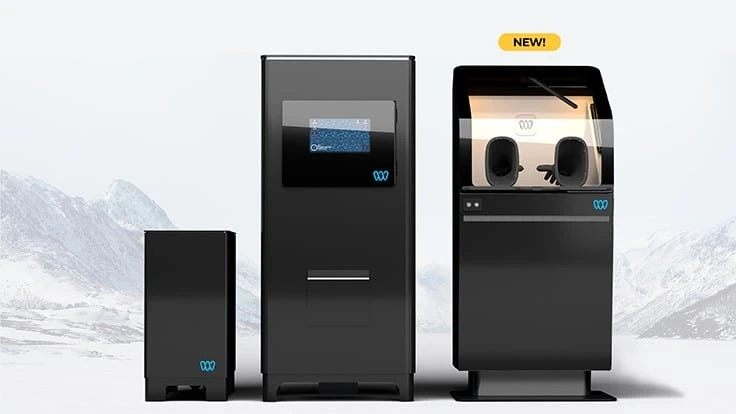
The Density 2021 Gen II, a part of Wematter’s ecosystem for additive manufacturing (AM), reduces the time it takes to go from a 3D-printed part to a finished end product.
After taking a holistic approach to exterior design, functionality, and reliability, the company looked inside its machine to present the next generation of the waterjet cabinet Density 2021 that makes the cleaning process in AM shorter. Shorter cleaning after every print job avoids bottlenecks in the 3D printing production. With Density, the user post-processes printed parts with water and compressed air, helping to reduce post-print cycle times, enhancing productivity.
A quick and safe post-processing method
The new changes, at their core, still use high-pressure water to treat powder-based 3D prints after printing. This is a method that is gentle compared to other AM blasting techniques to avoid affecting the surface structure of the prints. This unique offering is enhanced by a new feature for quickly testing prints after water blasting by selecting the Density’s drying feature, utilizing a compressed air gun.
“This new model has not only taken the machine’s visual design to the next level; the changes to Density 2021 Gen II also improve the user’s workflow while significantly reducing maintenance for each unit,” explains Robert Kniola, founder, and CEO of Wematter.
“By first using water to remove excess material with Density, you can clean 3D models quickly and safely compared to using only compressed air. In comparative tests, we have in some cases measured a reduction in the finishing time by up to 83%. From one hour to ten minutes per batch of 3D prints,” Kniola says.
A versatile solution for several manufacturing techniques
Another advantage of the ecosystem is that it is easy to install, which still applies to Density Gen II. The water recirculates in a closed system. This means that you do not need access to a drain or external water connection. The compressed air is driven by an integrated compressor and Density connects to a standard wall socket, meaning that you can place it almost anywhere to really decentralize AM in organizations.
“The versatility makes Density 2021 Gen II the obvious post-processing choice for 3D printers. Regardless of whether you are cleaning powder in the Powder Bed Fusion segment or removing wax from a PolyJet-printed part. Or even removing soluble support structure such as polyvinyl acrylate from an FDM print,” Kniola concludes.
- Some of the new features in the Density 2021 Gen II
Ergonomic hatch for loading 3D-prints with a dome of impact-resistant glass; open from the front and a gas spring holds it up - A larger protective window that lets in more light and provides better visibility
- A larger filter that collects more excess powder before it saturates; Placed inside the chamber which facilitates filter replacement and maintenance
- Larger chamber volume that provides increased water capacity, including visual flood protection. This enables larger and more 3D prints per job
- Integrated compressed air activated at the touch of a button. Used to dry prints faster or to blow away residual powder in cavities
- Gloves in a new position and with a new shape; Allows users of varying heights to find a comfortable working posture
- Fully cast cleaning chamber with continuous sweeping surfaces together with a dehumidification system for a hygienic environment
Density 2021 Gen II will be available as a part of the Gravity SLS ecosystem which is rented via a monthly subscription but also as a stand-alone solution for companies who want to complement their existing 3D-printing post-processing.